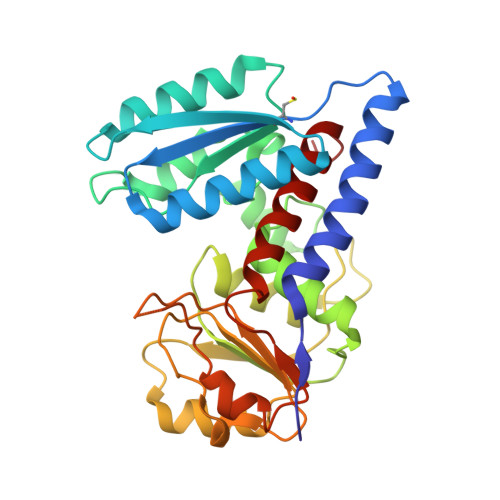The First Structure of Human MTHFD2L and Its Implications for the Development of Isoform-Selective Inhibitors.
Scaletti, E.R., Gustafsson Westergren, R., Andersson, Y., Wiita, E., Henriksson, M., Homan, E.J., Jemth, A.S., Helleday, T., Stenmark, P.(2022) ChemMedChem 17: e202200274-e202200274
- PubMed: 35712863
- DOI: https://doi.org/10.1002/cmdc.202200274
- Primary Citation of Related Structures:
7QEI - PubMed Abstract:
Methylenetetrahydrofolate dehydrogenase 2 (MTHFD2) is a mitochondrial 1-carbon metabolism enzyme, which is an attractive anticancer drug target as it is highly upregulated in cancer but is not expressed in healthy adult cells. Selective MTHFD2 inhibitors could therefore offer reduced side-effects during treatment, which are common with antifolate drugs that target other 1C-metabolism enzymes. This task is challenging however, as MTHFD2 shares high sequence identity with the constitutively expressed isozymes cytosolic MTHFD1 and mitochondrial MTHFD2L. In fact, one of the most potent MTHFD2 inhibitors reported to date, TH7299, is actually more active against MTHFD1 and MTHFD2L. While structures of MTHFD2 and MTHFD1 exist, no MTHFD2L structures are available. We determined the first structure of MTHFD2L and its complex with TH7299, which reveals the structural basis for its highly potent MTHFD2L inhibition. Detailed analysis of the MTHFD2L structure presented here clearly highlights the challenges associated with developing truly isoform-selective MTHFD2 inhibitors.
- Department of Biochemistry and Biophysics, Stockholm University, Svante Arrhenius väg 16 C, Stockholm, 106 91, Sweden.
Organizational Affiliation:



















